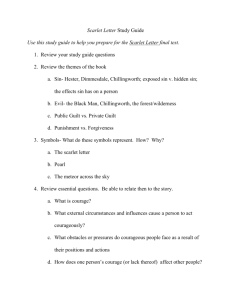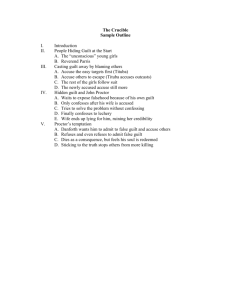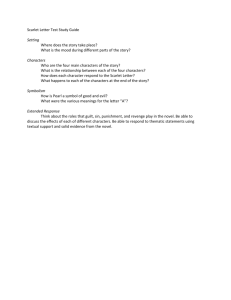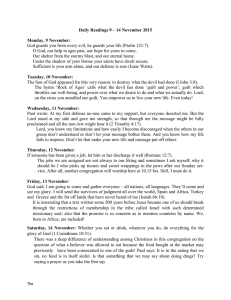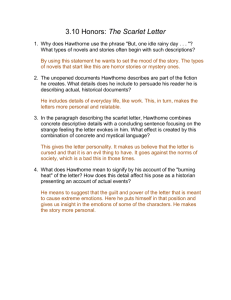File - Hannah Rowden
advertisement
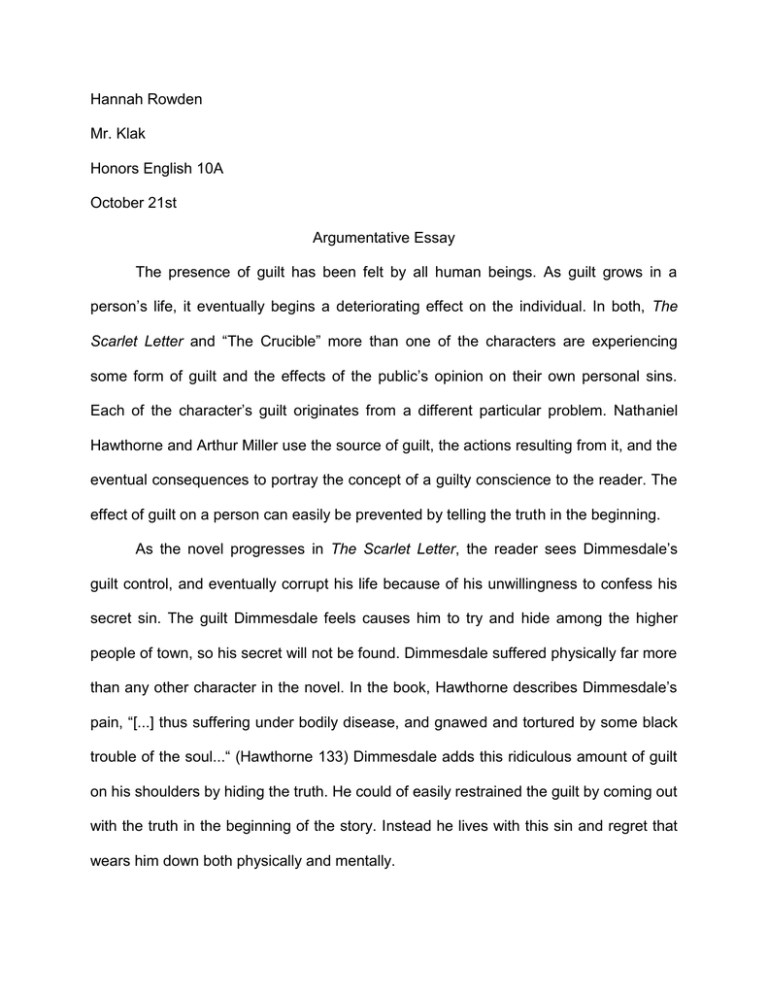
Hannah Rowden Mr. Klak Honors English 10A October 21st Argumentative Essay The presence of guilt has been felt by all human beings. As guilt grows in a person’s life, it eventually begins a deteriorating effect on the individual. In both, The Scarlet Letter and “The Crucible” more than one of the characters are experiencing some form of guilt and the effects of the public’s opinion on their own personal sins. Each of the character’s guilt originates from a different particular problem. Nathaniel Hawthorne and Arthur Miller use the source of guilt, the actions resulting from it, and the eventual consequences to portray the concept of a guilty conscience to the reader. The effect of guilt on a person can easily be prevented by telling the truth in the beginning. As the novel progresses in The Scarlet Letter, the reader sees Dimmesdale’s guilt control, and eventually corrupt his life because of his unwillingness to confess his secret sin. The guilt Dimmesdale feels causes him to try and hide among the higher people of town, so his secret will not be found. Dimmesdale suffered physically far more than any other character in the novel. In the book, Hawthorne describes Dimmesdale’s pain, “[...] thus suffering under bodily disease, and gnawed and tortured by some black trouble of the soul...“ (Hawthorne 133) Dimmesdale adds this ridiculous amount of guilt on his shoulders by hiding the truth. He could of easily restrained the guilt by coming out with the truth in the beginning of the story. Instead he lives with this sin and regret that wears him down both physically and mentally. Equally important, “The Crucible” uses the relationships between a man and a woman as a primary source of guilt. The men in both cases are experiencing guilt involving mistakes made sexually. John Proctor is a married man that falls for a young girl and commits adultery. Proctor confesses to his wife right away even though she still had a suspicion. In an argument with his wife he says, “[...] I should have roared you down when you first told me your suspicion. But I wilted, and, like a Christian, I confessed…” (Miller 55) Elizabeth describes Proctor’s feeling of guilt by “The magistrate that sits in his heart.” (Miller 55) Miller seems to hint in the first scene that John Proctor was attracted to Abigail’s subversive personality. If Abigail and Proctor did not build on lie after lie the entire trial would not have happened. Telling the truth can advert a full series of complications. Why does it seem easier to mask the truth rather than face it? Research by University of Massachusetts psychologist Robert S. Feldman revealed that 60 percent of people lied at least once during a 10 minute conversation and told an average of two to three lies. I believe that it is easier to come out with the truth in the beginning then to build on lie after lie. Although, opposing views claim that at the time it is okay to bury the truth. These people live in the moment and do not look into the consequences of the future. This opinion may be alright for that time but not for later on. Piling on lies just makes the dilemma larger than it should be. One cannot deny that they have not done this before. At the same time, if you put more thought into your situation, predicaments can be prevented. Therefore, telling the truth from the start is the better way to go to stop the unnecessary problems. Concluding, The Scarlet Letter and “The Crucible” both show symbols of guilt and hiding the truth. There are two conflictions to either mask the truth or show it. As we learned throughout these novels, masking the truth only concludes in a brimming dilemma. Coming out with the truth from the starting point is much more simple than building on lies. Building on lies causes difficulties leading up to situations that are worthless. Not only does it cause problems, it also causes guilt. Lying always results in regrets. Guilt can influence the way a person physically feels just as much as they mentally feel. Just like Dimmesdale in The Scarlet Letter, his guilt knocked the life out of him. His guilt created this enormous amount of weight on his shoulders that wore his body until he could not take it anymore. All in all, to avoid the unnecessary conflicts and the pain of guilt, do not disguise the truth as something else. The truth will always come out one way or another. Works Cited Page Hawthorne, Nathaniel. The Scarlet Letter. London, England: Signet Classics, 2009. Print. Miller, Arthur. The Crucible. New York, NY: Penguin, 1996. Print.

